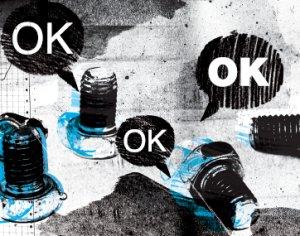Quality Control -- A Matter of Taste
By Michael O.B. Krähe and Florian Kohlbacher
Respecting customers’ quality requirements
The words ‘Made in Japan’ are now synonymous with high quality, reliability and worthy of the investment. However, in the beginning of the postwar era, goods marked “Made in Japan” were regarded as inferior and cheap in the world market. The small town of Usa, in northern Kyushu, experienced brief economic growth when it started marking products “Made in USA.”
Japan managed to turn this all around in the eyes of the world and developed as one of the strongest export-oriented economies in the world. The early ’70s saw “Made in Japan” become the symbol of a strong, export-oriented and self-confident nation and although Japan ceased to be a role model for management techniques and economic strategies in the early ’90s, in the field of product quality, it remains distinctive in the world market.

Yet the popular belief that the Japanese demand higher quality products is wrong— industry customers just have different product requirements compared to what foreign manufacturers may be used to in their home countries.
What you asked for is what you get
A Western engineer does not care whether a machine is yellow, green or purple as long as it will function perfectly as required. A Japanese engineer, on the other hand, is convinced that if he asked for a green machine, only a green machine will function properly and thus it is crucial to check if the machine is the same green that was specified.
It can be concluded that it is more important to check a predefined set of specifications against the actual product, than it is to ensure the impeccable function of the product itself. In short, form before function.
The perfect appearance
It seems to be embedded in the Japanese psyche that only a perfect-looking product can function properly. This does not necessarily equate to a great product design, but rather that the product looks new in all aspects without any scratches or damages. It also doesn’t matter if the end-customer gets to see the product or not. For example, when Schindler, the Swiss elevator manufacturer, manufactured its elevators in Japan, it would pay extreme attention to the finish of the car interior panels. Schindler’s clients would send a team of inspectors to the factory, even though afterwards those panels were going to be covered with carpeting anyway.
Another aspect of strict product specifications can be found in packaging, which is seen as part of the product itself. The packing is not actually used to protect the product from possible damage through transport—for this, more packing material is needed—the packaging is necessary for appearance. For instance, Panasonic packs up regular household batteries in transparent packages so that all are aligned in exactly the same direction.
Always looking the same
Once a product is chosen and the customer has received the samples, the supplier needs to make sure that the subsequent deliveries match the specifications and samples exactly, and that no changes are made without consulting the customer. Although this sounds obvious, it actually comprises of many aspects that are not fixed in written form, do not have any impact on functionality and are usually regarded as negligible. A customer of a German importer of furniture fittings refused a delivery of screws because the color of the galvanization was slightly different from the screws in the previous delivery. There was no problem with the functionality or the durability, and on top of this, the screws are invisibly mounted and the end-users won’t ever see them. Japanese customers may regard variations that seem unimportant to the supplier, as a problem in quality until they are clarified.
One reason for this view is because everything is seen as somehow being connected to something else, and all variations, regardless of their degree, are suspicious. If the supplier had proper quality management, they would know about the variations and would have informed the customer, but they had not. Therefore, their quality management is seen as being poor and the product as having a ‘quality problem.’
 Details which may seem small to foreign companies may mean the difference between success and failure in Japan.
Details which may seem small to foreign companies may mean the difference between success and failure in Japan.
This leads to another topic: certification. The typical Japanese customer has deep faith in the value of certificates. The more certificates and documents are provided, the better. One must also get used to the fact that many requirements are hardly relevant and seldom have an impact on the functionality or the quality of the product; the certification rather, serves as a safeguard for the supervisors involved on the Japanese customer’s side.
Twice as heavy, twice as good?
Apart from the globally competitive automobile, electronic and shipbuilding industries, many industrial sectors in Japan produce almost exclusively for the domestic market and do not have to face foreign competitors. These companies naturally tend to “over-design” as they have less cost pressure and often serve their customers for many years and so high quality becomes more important for success than reducing production costs.
When a foreign manufacturer goes against these local competitors, they usually have to challenge products that are twice as large and bulky, made with better materials, and with higher-quality components. Arguing against these market standards or calling them unnecessary, lavish or of no importance to the end-user is futile, as it only gives the impression that the foreign competitor has not understood the requirements of the market.
Also, a clear difference is made between manufacturers and distributors. As a rule, an importer of foreign goods will be less responsible than the manufacturer’s representative in Japan. The manufacturer bears full responsibility for a product no matter how many years have passed since delivery and through which channels it has been distributed. A typical yet unfortunate example is Schindler, again, which was involved in a fatal accident in 2006. The elevator was installed in 1997, and even though another company had conducted the maintenance and therefore they were at least partly responsible, 99 percent of the media investigations concentrated on Schindler alone while the local maintenance company was hardly mentioned.
Importance of product liability
Reports of systematic quality defects regarding products from different industrial sectors have been increasing in the media over the last few years. Among these shamed and shunned companies are: Paloma for its continuous-flow water heaters, Mitsubishi-Fuso for its trucks, Sanwa Shutter’s revolving doors, Meathope meat and Fujiya dairy products. Apart from the legal consequences, the ramifications in the media play a large role in putting the pressure on Japanese manufacturers. The public holds a Japanese company which purchases defective components from a foreign supplier fully responsible for its products. Discussions of this kind are often extremely emotional, not always logical and fought out extensively and bitterly. Thus it is reasonable to assume that a Japanese customer considers more quality issues than necessary at first sight.
Finally, it is worth noting that a rejection, apparently related to quality issues, could also have a very different cause. A distributor of foreign products must talk to the customer and find out if quality modifications according to the customer’s needs really lead to sales or if the potential customer is just looking for an excuse to back out of the deal. Arguments such as “German sausage—incompatible for Japanese stomachs,” “European skis—don’t glide on Japanese snow,” or, heard during the rice crisis of 1996, “Thai rice—not suitable for making sushi” do not have anything to do with quality requirements.
The issues involved with product quality are unique to Japan. If companies want to be successful, they must be ready to pay extra attention to certain unusual quality aspects and keep customers’ minds at ease. Minute details, which may not seem to matter to manufacturers at home, may be the difference between success and failure in Japan. Foreign companies must realize that what may seem like an unwarranted expense is, in fact, essential in one of the most lucrative markets in the world. ‘Made in Japan’ is synonymous with quality and so, if companies want to be ‘Bought in Japan,’ they need to be as well.
Authors
Michael O.B. Kraehe has lived and worked in Japan, on and off, since 1990. After gaining experience in purchasing, logistics and marketing, he became head of Hafele Japan K.K. In 2006.
Dr. Florian Kohlbacher has lived and worked in Japan, on and off, since 2000. After gaining experience in academic science and business at various universities and corporations, he joined the German Institute for Japanese Studies (DI J) in April 2007 as a research fellow.
An earlier version of this article was published in German in the November 2007 issue of JAPANMARKT, the leading business magazine on Japan in German language published monthly by the German Chamber of Commerce and Industry in Japan (GCCIJ) in cooperation with the Swiss Business Hub Japan. The authors would like to thank Julia Lange for her help in translating the article.





